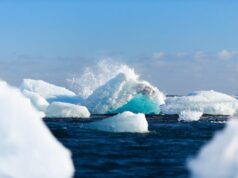The drastically increasing influence of humans on Earth’s climate causes a melting of polar ice sheets and therefore a rise in global sea levels. A team of international scientists led by the Institute of Earth Sciences at Heidelberg University and including the University of Southampton has now analyzed the response of the largest ice sheet on Earth—the East Antarctica Ice Sheet—to a warming climate.
Based on geochemical data obtained from deep-sea sediments, the study sheds new light on the factors that determine the stability of the East Antarctic Ice Sheet. It suggests that under an increasingly warming climate, as expected for the near future, the East Antarctic Ice Sheet could be less stable than previously thought.
“The future melting of polar ice sheets and the associated rise in global sea level as a consequence of climate change will have a substantial impact on low-elevation coastal areas,” emphasizes Dr. Kim Jakob from Heidelberg University. To better understand the behavior of the East Antarctic Ice Sheet in a world that is warmer than that of today, the scientists performed geochemical analyses of deep-sea sediments from the Atlantic Ocean obtained through the international Integrated Ocean Drilling Program.
The study focuses on the time interval from around 2.8 to 2.4 million years ago—a period in which atmospheric CO2 levels were similar to today. The results show an increase in the stability of the East Antarctic Ice Sheet from about 2.5 million years ago. This stability has lasted until the present day, with only short-term interruptions during exceptionally warm phases.
Factors that are typically accepted to have controlled the growth and decay of polar ice sheets during Earth’s history are solar radiation and the CO2 content of the atmosphere. However, this new study found that an additional factor played a decisive role in making the East Antarctic Ice Sheet stable: the formation of large ice sheets in the Northern Hemisphere, which caused global sea levels to fall. This sea-level fall reduced the exposure of the East Antarctic Ice Sheet to relatively warm ocean waters which have the potential to melt underwater parts of the ice sheet.
Find your dream job in the space industry. Check our Space Job Board »
Professor Paul Wilson of the University of Southampton’s Ocean and Earth Science department said, “Our data provide an unusually high-resolution image of changes in ocean temperature, ice volume and sea level for an interval when atmospheric CO2 levels were last as high as they are today. We can see that before 2.5 million years ago in our records peak sea levels were so high that some of even the biggest lump of ice on Earth, the East Antarctic Ice Sheet, melted.
These findings shed light on the behavior of polar ice sheets under higher atmospheric greenhouse-gas concentrations, as expected for the near future. The outcome of their study highlights the vulnerability of the East Antarctic Ice Sheet to global warming and the risk of a renewed destabilization of ice sheets in East Antarctica triggered by ongoing sea-level rise.
Professor Wilson added, “We suspect that the melting occurred in areas where the Antarctic Ice Sheet was in contact with a rising, warming, ocean driven by retreat of other ice sheets in the northern hemisphere; a sort of vicious circle.”
Their study entitled “A new sea-level record for the Neogene/Quaternary boundary reveals transition to a more stable East Antarctic Ice Sheet” was published today in the journal Proceedings of the National Academy of Sciences.
Provided by: University of Southampton
More information: Kim A. Jakob et al. A new sea-level record for the Neogene/Quaternary boundary reveals transition to a more stable East Antarctic Ice Sheet. Proceedings of the National Academy of Sciences (2020). DOI: 10.1073/pnas.2004209117
Image: Exposure to warm ocean waters is a large threat to the stability of ice sheets.
Credit: Jörg Pross











